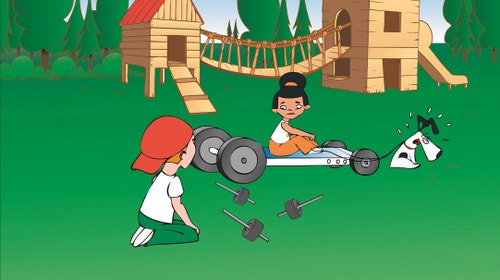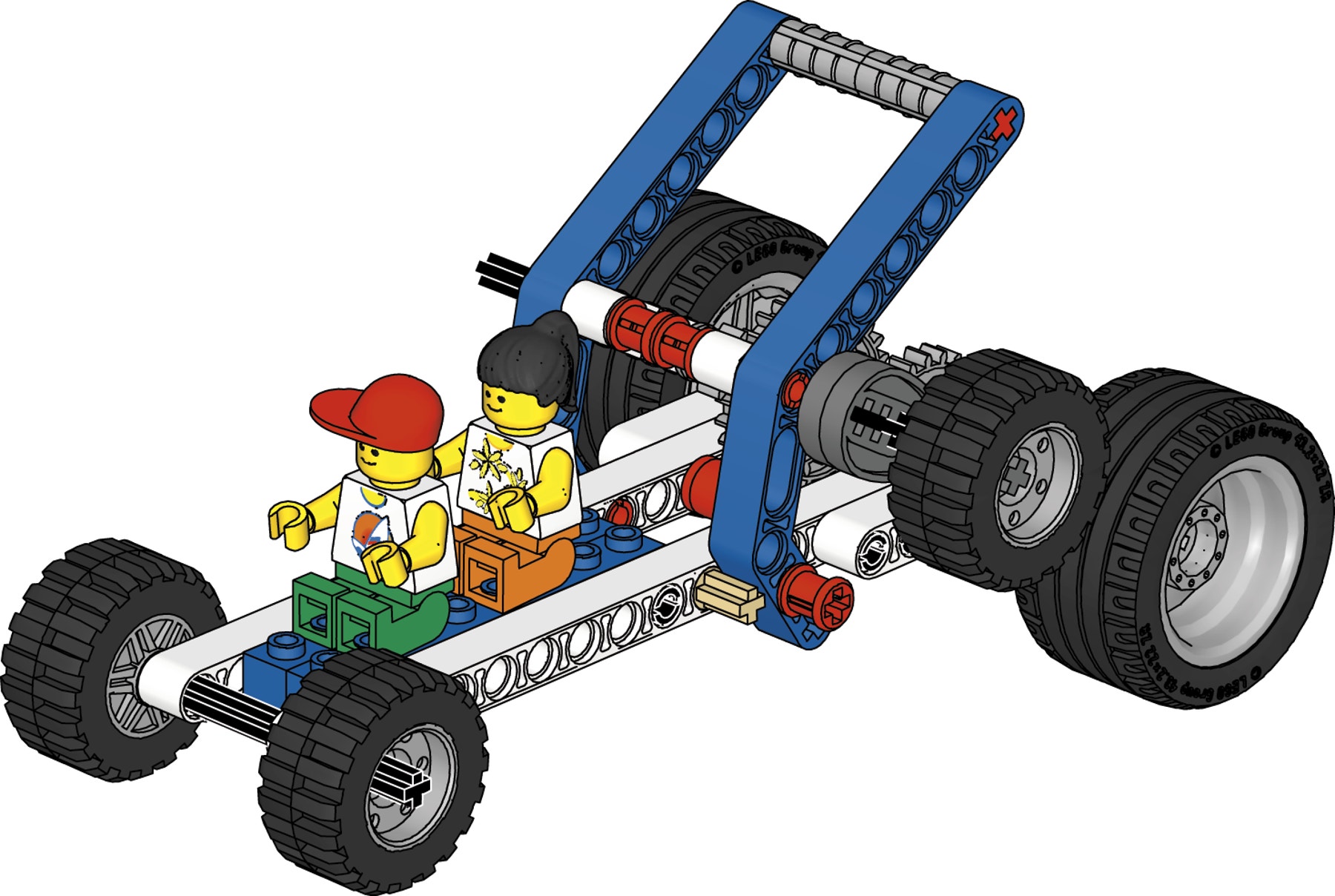Flywheeler
Explore the scientific concepts of gearing up, measuring distance, forces, moving energy, friction and air.

Connect
(5-10 Minutes)
Jack and Jill have had a little quarrel and have been sent outside to cool down. Jill gets Zog the Dog to pull her on the cart, but it is far too slow.
Jack plays with his spinning tops. They spin very fast, but really he would much rather be friends with Jill and play with her again. Jill feels exactly the same – it is much better when they are good friends, and quite frankly, they are bored playing games that are not fun.
They look at each other and suddenly Jill gets an idea. How about a combined game using both the cart AND the power of the spinner? Will that work, do you think?
Could the spinning of a spinning top help a push-along car move and will it travel further – and for a longer time?
Let’s find out!

Construct
(20-25 Minutes)
Make the Test Track
Mark out a 50 cm (≈ 19.5 in) section of run-up track. This is the run-up zone and in front of the launch line. Then stick a 2 m (≈ 2 yd) strip of masking tape along the floor and mark it off every 10 cm (≈ 4 in). Now we are ready to build models!

Build the Flywheeler
(all of book 10A and book 10B to page 10, step 20)
When pushed it should roll to a stop quite slowly
If it slows too soon, loosen the axle bushings, make sure gears are meshing properly, and make sure all other elements are pressed firmly together


Contemplate
(20-25 minutes)
Fair Testing
To fair test each model, use a 2-second run-up over 50 cm (≈ 19.5 in) and release at the launch line – at the same speed. It takes practice! This is why it is a good idea to test each model three times to be sure.
Did you know?
The best energy storing flywheels are put inside an airtight case and run in a vacuum to remove air resistance!

What makes a good flywheel?
The best flywheel will carry the model further, and roll for a longer time – with exactly the same run up! Try it without any flywheels at all!
Try the big hub with and without its tire. Invent your own combinations too.
Heavier flywheels work better than lighter ones, but they need a lot of arm energy to get up to speed, i.e. the amount of moving or kinetic energy it stores depends on its weight and on the speed it is travelling.
How far and for how long will it roll?
Measure how far each flywheel rolls. Even better, but optional, time how long it rolls!
Build to page 12, step 22. Test and measure.
Build to page 14, step 24. Test and measure.
The flywheel cars travel very slowly. The bigger the flywheel – often the slower they travel – but the longer they run for and the further they go.
Did you know?
We use 8-tooth and 24-tooth gears to gear up. There are two gearing-up stages, each 1:3, i.e. one turn of the wheel on the ground gives 9 turns of the flywheel.

Continue
(25-30 Minutes)
Shakey Brakey!
Build book 10B to page 17, step 3 with a flywheel mounted off center.
Predict what will happen – then test it.
It stops the car very quickly! Flywheels must be DYNAMICALLY balanced when spinning, otherwise they produce large forces going in many directions, which increases FRICTION on the axles.
Try rolling Shaky Brakey down the hill. What happens? Compare it to rolling with the balanced flywheel.
It rolls very slowly and does not get faster.
Dynamic imbalance forces increase hugely with just a little increase in speed. At low speeds they are small, so the vehicle stays at a slow speed.
Did you know?
In real life, an off-balance super-fast flywheel can explode!

The Hill Climber
Make a ramp for the cars to run up. Predict and test how a flywheel and a non-flywheel car will perform with the same speed run up (this can be tricky!). You may want to work with some of the other teams in class on this activity.
The flywheel car travels further up the plank. It has a lot of stored energy.
Make a series of low hills for the cars to negotiate. Thin card taped over shoes or objects works well.
The flywheel car goes slowly both up and down the hills. It acts as kind of ‘controller’ to help cars get over hills at an even speed.
Taking on an Obstacle Course
Make a big pile of LEGO bricks on the floor or on the table and find out which type of flywheel it will take to cross the LEGO ‘mountain’.
The flywheel car with the big tires is best at forcing its way through the course and over the pile.

Teacher Support
Students will explore the concepts of:
Using mechanisms – gearing up
Assembling components
Measuring distance
Measuring time
Forces
Moving energy
Friction and air
Resistance
Scientific investigation
9686 Simple & Powered Machines Set (two students per set recommended)
3-meter (≈ 3 yard) strip of smooth floor
Masking tape
Meter stick (yard stick) or measuring tape
Timer or stopwatch
NGSS
Disciplinary Core Ideas: Physical Science
MS-PS3 Energy
Crosscutting Concepts
Cause and effect
Science and Engineering Practices
Developing and using models
Planning and carrying out investigations
Analyzing and interpreting data
Common Core Mathematics Standards
7.RP.A / 6.NS.B / 6.EE.C / 7.EE.B / 8.EE.B / 8.F.B / 6.SP.A
Common Core English Language Arts
SL 6.1 / 6.2 / 7.1 / 7.4 / 8.1
RST 6-8.3 / 6-8.4 / 6-8.7
WHST 6-8.1 / 6-8.7 / 6-8.8 / 6-8.9
Student Material
Share with:
 Google Classroom
Google Classroom



